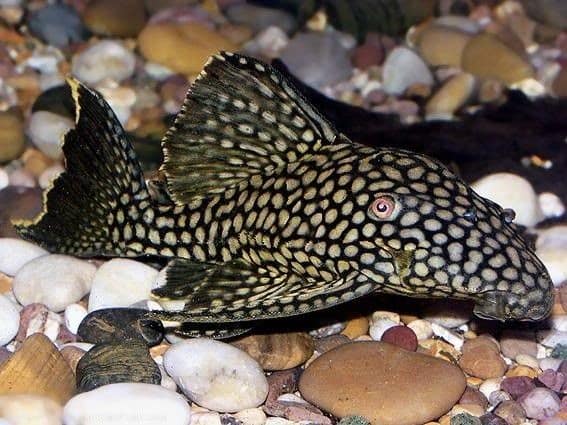
In 1988 authors working for the much respected German language magazine Datz launched the ‘L’ numbers scheme in order to form a universally recognised identification system for new loricarins arriving in the aquarium hobby from South America.
In the early 1990’s L77 became one of the first L numbered loricarins to appear in the U.K. At this time these fish were sold under the trade name of Panaque species ‘Bruno’. In the wild these fish are found in the Mato Grosso area of Brazil. Not as bulky in appearance as Hypostomus, and with a more pronounced ‘v’ notch in the tail, the body colour of L77 is a mixture of various shades of brown.
A couple of years later the scientific community announced that this species was not actually a Panaque but a close relative that belonged to the Cochilodon grouping. This brought about a name change to Salt and Pepper Plec. which would then give way to Coffee and Cream Plec. Surely the L77 tag would have been easier to follow?
Of all the L numbers L77 is probably the one most prone to white spot upon importation but, thankfully, this is easily treated by using the ‘old method’ of raising the water temperature and scurrilously siphoning the gravel.
In the wild, pairs build breeding nests in the hollowed out trunks of dead trees (devouring wood debris and various stages of insect life in the process) that periodically fall into the water, and this is causing some concern to ichthyologists working in the field, as commercial cattle ranching operators are starting to remove such trees as they fall in order to safeguard their cattle from potential injury as they cross rivers and streams from one bank to the other.
With L77 established within the aquarium hobby L137 and L138, both of which originate from the Rio Tapajos area of Brazil, suddenly made an appearance. Darker in body colours, L137 would come to us under the common names of the Violet Pleco, Violet ‘Bruno’ Plec. and Rusty Plec., whereas L138 was assigned the name Black-spotted ‘Bruno’ Plec.
Although many of the L numbers around them have now been assigned proper scientific names L77, L137 and L138 remain classed as ‘Cochilodon species’. When a scientific classification comes along it may well be that all three ‘Bruno’ species are given the same scientific name because they are so alike in features that only the slight differences in body colour tell one from the other. Yes this has caused confusion in the aquarium hobby with all three species currently carrying the Rusty Plec. tag.
Thankfully, from a hobby point of view, fish breeders in Eastern Europe appear to have ‘cracked the code’ as to how to get these fish to breed under aquarium conditions so, currently, we are seeing a large number of young L137, often for sale at under 1.6″, arriving in U.K. retail outlets.
Although their sucker-like mouths are adapted to chewing at wood, all three ‘Bruno’ species accept standard aquarium foods with great gusto. They are not fussy about water conditions – the L137 in my care is kept at a pH of 7 and at a temperature of 26 C. – and are not as demanding as Panaquespecies are over the addition of bogwood in their aquarium. Thankfully, as they age, these fish do not have the Hypostomus habit of weakened eyesight causing them to attack the neon light of aquarium heaters.
The first ‘Bruno’, L77, which came into my care happily, shared his aquarium with Keyhole Cichlids, large Synodontis and various barb and rasbora species. The youngster currently in my care gets along well with various Corydoras and Zebra Danios.
When my original ‘Bruno’ passed away he had been in my care for 10 years and had grown from 2″ to 10″ in this time.
If you have never kept any of the L numbered loricarins then the ‘Brunos’ make a great and hardy introduction to this side of the catfish hobby.
Leave a Reply